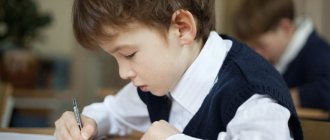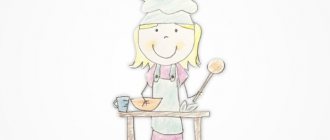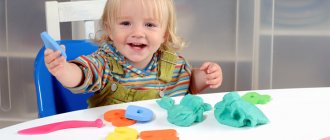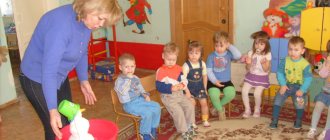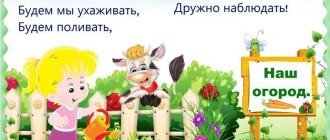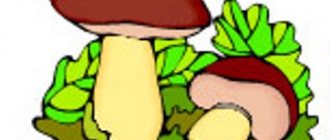Project for children of the younger group on the topic: “Space”
Published:
“CHEST” for teachers and parents https://vk.com/club_sunduk_ru
Educational – information project for primary preschool age on the topic: “Space”
Author:
Melnikova Valentina Nikolaevna, teacher, Moscow, .
Description:
This material will be useful for educators, teachers, and parents to use in order to involve children and adults in project activities.
Relevance of the project:
Modern children have ceased to be interested in the topic of space. In the 20th century, all children of the Soviet Union dreamed of becoming astronauts and played at being cosmonauts. In modern times, flights into outer space have become an everyday reality, and therefore children’s interest in astronautics is gradually fading away. It is necessary to interest modern children by creating for them a problematic game situation that they will want to “live” on their own.
Project type:
medium-term, educational - informational, group.
Project participants:
children of the second junior group, parents of students, group teachers.
Project duration:
4 weeks.
Implementation deadlines:
Target:
introducing children of primary preschool age to knowledge about Space; formation of cognitive, intellectual and creative abilities of children.
Objectives:
Educational:
• promote the formation in children of the concepts of “Space”, “astronaut”, “Outer space”;
• contribute to the expansion and deepening of ideas about the surrounding world of the Earth, and about the role of man in its system; Educational:
• to cultivate respect and love for our Earth as a cosmic miracle;
• cultivate respect for the astronaut profession and a sense of patriotism; • cultivate the desire to be strong and courageous; Developmental:
• enrich the active and passive vocabulary of pupils; • develop the child’s psychological functions: speech, imagination, attention, memory, thinking, as well as interest in learning, observation.
Preliminary work:
• Study and selection of scientific, methodological and fiction literature, visual material and educational literature. • Drawing up recommendations for parents “Cosmonautics Day”, “What to tell your child about space?”; • Reading fiction to children on the topic “Space”; • View illustrations, pictures, cards and encyclopedias on the topic “Space”; • Homework for parents: together with the children, draw any planet you like and find information about it, then tell and show it to other children; • Design a homemade book “Secrets of Space”.
Project implementation stages:
1. Preparatory stage (collection of information on the problem):
• Preparation of materials and equipment, literature, pictures on the topic. • Carrying out diagnostics of children to identify initial knowledge about space. • Informing parents about upcoming project activities. • Selection of scientific, methodological and fiction literature about space, photographs, illustrations, posters. • Selection and production of material for carrying out productive activities, production of a card index of didactic games on the topic “Space”.
2. Main stage:
• Conversation “What is Space?”
(abstract); • Conversation “The first flight of Yu. A. Gagarin” (compendium); • Conversation “Acquaintance with the model of the Earth - the globe” (compendium); • Story-based role-playing games “Space Rescuers”, “Flight into Space”; "Space Cafe"; “Aliens have come to us”; (card file); • Didactic games: “Assemble a rocket”, “Assemble a constellation”, “Star map”, “Starry sky” (game guide, pictures, photographic material); • GCD “Blue Planet - Earth”, “The Sun is a huge star”, “Day follows night” (compendium); • Exhibition of fiction (photo material); • Consultation for parents: “How to introduce preschoolers to the concept of “Space” (consultation); 3. Final stage:
• Organization of an exhibition of joint creativity by children and their parents (photo material, exhibition); • Exhibition of drawings and crafts from various materials on the theme: “This mysterious space!”;
Expected result:
Children:
• Development of basic knowledge on the topic “Space” in younger preschoolers; • Formation of moral and patriotic feelings in the process of project implementation; • Demonstration of children’s cognitive activity: together with their parents, they find information on the topic, tell and share their knowledge with other children in kindergarten; • Children's initiative to design from building materials, Lego, paper, rockets according to their own ideas, displaying creativity and detail in their work. • The opportunity to participate in a project presentation, where children will be able to apply their existing knowledge about space and cosmic phenomena, participate in fun contests and competitions, and present their drawings and crafts.
Parents:
• Celebration of the Russian holiday – “Cosmonautics Day”.
• Acquisition of knowledge and practical skills by parents when interacting with the child. • Exchange of experience in family education between teachers and parents. • Formation of partnerships, parents, children and teachers, in the joint organization of group life. Educators:
• Systematization and improvement of the quality of work with children on the development of cognitive and research abilities through various types of productive activities. • Increasing the level of pedagogical competence in mastering modern educational technologies (project activities of preschoolers); • Dissemination of pedagogical experience in the use of non-traditional visual technologies, mnemonics, and electronic educational resources.
Productive activities of the educational and information project:
For children:
• homemade books “The First Cosmonaut of the Earth”, “My Constellation”, “Riddles about Space”, “Me and Space”; • making a coloring book on the theme “Space”; • drawing with unconventional techniques on the theme “Space”; • designing rockets: from paper, boxes, waste material, various construction kits; • plasticineography “Rockets”, “Starry Sky”; • drawing “Mysterious Space”; • collage, joint work of children “Earth is a cosmic miracle!”; • work with waste material “Aliens on Earth”; • exhibition of books and manuals on the topic: “Space”;
For teachers:
• development of a thematic project on the topic: “Space” for children and adults;
• selection of computer presentations; • exhibition of fiction, encyclopedias about space; • selection of materials for parents: folders, photo newspapers, screens; • selection and recommendations of literature to read with children; • production of card indexes of outdoor games, physical education minutes, dynamic breaks, moving folders, wall newspapers on the topic “Space”; For parents:
• folders—movements about astronauts, information stands and newspapers dedicated to “Cosmonautics Day”; • final exhibition of artworks and crafts made by children in independent and joint activities with parents on the theme “Space”;
We used the following principles:
• the principle of activity and consciousness, which requires the activation of children’s activities, the development of their independence in the process of mastering all components of the content of education and upbringing; • the principle of an individual approach combined with the principle of collective organization of children's activities; • the principle of systematicity and consistency - the development of children in the logic “from simple to complex”, “from close to distant”, “from well-known to little-known and unfamiliar”; • the principle of conformity to nature, which establishes the tasks of artistic and creative development of children, age characteristics and individual abilities; • the principle of aesthetics, which is focused on universal human values (education of a thinking, feeling, creating person).
Methods and techniques:
• method of examination, visualization (examination of illustrations, albums, videos, presentations, etc.); • verbal method (conversation, use of literary words, explanations); • practical method (children do the work independently, use various tools and materials for the image); • heuristic method (development of resourcefulness and activity); • problem-motivational (stimulates children’s activity by including a problem situation during the lesson).
Used Books:
1. Bondarenko T.M., Environmental classes with children 6-7 years old: a practical guide for educators and methodologists of preschool educational institutions / T.M. Bondarenko. – 2nd edition, corrected and expanded. – Voronezh: Teacher, 2007. – 190 p. – (Pedagogy of modern times). 2. Knushevitskaya N. A, Poems and speech exercises on the topic “Space”. Development of speech and logical thinking in children //Publishing house: Gnom: 2016 - 40 pp. - (Series: “Acquaintance with the outside world and development of speech”). 3. Natarova V.I. My country. Revival of national culture and education of moral and patriotic feelings. Practical guide for educators and methodologists of preschool educational institutions// - Voronezh TC “Teacher”, 2005.-205p. 4. Nosov N. Dunno on the Moon // Publisher: Eksmo, 2015, - 536 p. 5. Pervushin A., Pervushina E., I am discovering space! The first journey through the Solar System // Publisher: Kacheli, 2021, - 32 p., (Series: Whychkina book). 6. Shorygina T. A. Children about space and Yuri Gagarin - the first cosmonaut of the Earth: Conversations, leisure, stories. M.: TC Sfera, 2021. – 128 p. – (Teacher's Library) (3). 7. Shorygina T. A.: Conversations about natural phenomena and objects. Guidelines. M.: TC Sfera, 2015. – 96 p. 8. Encyclopedia: Space and Earth. A unique illustrated encyclopedia for children. Publishing house "AST", 2021. - 72 p.
Annex 1
Questioning parents: “What do you know about space?”
Dear parents! The kindergarten is conducting a survey of parents to identify knowledge about space. Read the questions carefully and answer them. Thank you in advance for participating in the survey. FULL NAME. parent_______________________________________________________________ 1. What is the name of the largest star?________________________________________________ 2. How many planets are in the solar system?_________________________________ 3. What is the name of our planet Earth?________________________________________________ 4. What satellites of the planets do you know?_________________________________________________ 5. What is the name of the first cosmonaut?________________________________________________ 6. What is the name of the first one? a woman astronaut?__________________________________________ 7. What is the name of the last space station?______________________________ 8. What books about space do you have at home?_____________________________________________ Appendix 2
Monitoring children’s knowledge about space. F.I. child__________________________________________________________ 1. What is the name of the planet on which we live?_________________________________ 2. What other planets do you know?__________________________________________ 3. What do they use to fly into Space?_______________________________________________ 4. Why do they fly into Space?________________________________________________ 5. Who was the first living creature to fly into Space? __________________________ 6. What was the name of the first person who flew into space?___________________________ 7. What is the name of the Earth’s satellite?_________________________________________ 8. What books about space do you know?________________________________________
Appendix 3
Children's experimental activities
Experience No. 1 “Making a cloud”
Purpose:
to introduce children to the process of forming clouds and rain.
Equipment:
three-liter jar, hot water, ice cubes.
Procedure of the experiment:
It is necessary to pour hot water (about 2.5-3 cm) into a three-liter jar.
Next, put a few ice cubes on a tray and place it on the jar. The air inside the jar will begin to cool as it rises. The water vapor it contains will condense, forming clouds. This experiment simulates the process of cloud formation as warm air cools. Where does rain come from? It turns out that the drops, having heated up on the ground, rise upward. There they become cold, and they “huddle” together, forming clouds. When they meet together, they increase in size, become heavy and fall to the ground as rain. Experiment No. 2: “Solar System” Purpose:
explain to children why all the planets revolve around the Sun.
Equipment:
yellow wooden stick, thread, 9 balls.
Progress of the experiment:
Imagine that the yellow stick is the Sun, and 9 balls on strings are the planets. We rotate the stick, all the planets fly in a circle, if you stop it, then the planets will stop. What helps the Sun hold up the entire solar system?
— The sun is helped by perpetual motion. — That’s right, if the Sun doesn’t move, the whole system will “disintegrate” and won’t act—perpetual motion. Experiment No. 3: “The Sun and the Earth”
Purpose:
to explain to children the relationship between the sizes of the Sun and the Earth.
Equipment:
large ball and bead.
Progress of the experiment:
The dimensions of our beloved star are small compared to other stars, but by earthly standards they are huge.
The diameter of the Sun exceeds 1 million kilometers. Agree, even for us adults it is difficult to imagine and comprehend such dimensions. “Imagine, if our solar system was reduced so that the Sun became the size of this ball, then the earth, along with all the cities and countries, mountains, rivers and oceans, would become the size of this bead. Experiment No. 4: “Day and Night” Purpose:
to explain to children why there is day and night.
Equipment:
flashlight, globe.
Progress of the experiment:
It is best to do this on a model of the solar system! You only need two things for it - a globe and a regular flashlight. Turn on a flashlight in a darkened group room and point the beam at the globe, approximately your city. Explain to the children: “Look, the flashlight is the Sun, it shines on the Earth. Where it is light, it is already day. Now, let’s turn it a little more - now it’s shining on our city. Where the rays of the Sun do not reach, we have night.” Ask children what they think happens where the line between light and dark is blurred, I’m sure any child will guess that it’s either morning or evening.
Appendix 4
Poems about space
Author: Yu.Sinitsyn
“That’s it,” I said firmly at home, “I’ll only be an astronomer!”
An Extraordinary Universe Around the Earth! How tempting it is to become an astronomer, intimately familiar with the Universe! It would not be bad at all: Observe the orbit of Saturn, Admire the constellation Lyra, Discover black holes And certainly compose a treatise - “Explore the depths of the Universe!” Milky Way
The black velvet of the sky is embroidered with stars.
A bright path runs across the sky. It spreads easily from edge to edge, as if someone spilled milk across the sky. But, of course, there is no milk or juice in the sky. We see our star system, so we see it from the side. This is how we see the Galaxies. Our native distant light is space for astronautics for many thousands of years. Stars Author: Rimma Aldonina
What are stars?
If they ask you, answer boldly: Hot gas. And add that, moreover, there is always a Nuclear Reactor - Every Star! Constellations Author: Vasily Lepilov
Stars, stars, for a long time You have forever riveted Man's greedy gaze.
And sitting in animal skin near the red fire, he could gaze steadily into the blue dome until the morning. And the Man looked in long silence into the vastness of the night - Now with fear, Now with delight, Now with a vague dream. And then, together with a dream, a fairy tale ripened on the lips: About mysterious constellations, About unknown worlds. Since then, Aquarius, Sagittarius and Swan, Leo, Pegasus and Hercules have lived in the sky, As in the night land of miracles. Constellations
Above the Earth late at night, Just stretch out your hand, You will grab the stars: They seem nearby.
You can take a Peacock feather, touch the hands on the Clock, ride a Dolphin, swing on a Scale. Over the Earth late at night, If you look into the sky, You will see constellations hanging there like grapes. Over the Earth late at night, Just stretch out your hand, You will grab the stars: They seem nearby. Funny astronomy for kids (fragment) Author: Rimma Aldonina
They stand in a circle and dance gloriously with Capricorn Aquarius, Pisces waves their fins, Aries hurries into the circle quickly.
And Taurus will be next to him, He tap dances dashingly. There will be a dance until you drop, a round dance will be good. The twins are spinning in a dance, Cancer is backing behind them: “What kind of strange dance is this? Circle or belt? - Zodiac! Leo and Virgo became friends, They twirled in a round dance, Taking with them Libra of amazing beauty. Scorpio dances in a squat position and waves its claw at Sagittarius. This glorious round dance will go around the Sun in a year. There are twelve of them in a round dance, but there seem to be more in the sky? “How many constellations are there?” - let's ask! “Exactly eighty-eight!” Constellations Ursa Major and Ursa Minor Author: G. Sapgir
Here is the Ursa Major, stirring the stellar porridge with a Large ladle In a large cauldron.
And nearby the Little Dipper glows dimly. Collects crumbs with a small ladle. Ursa Major Author: V. Orlov
The handle of the Big Dipper is painfully good!
Three stars - and all in a row, like diamonds, they burn! Among the stars, large and bright, Another one is barely visible: She nestles in the middle of the handle. Take a closer look, Do you see how two stars have merged? The one that is larger is called the Horse. And the baby next to her is the Horseman galloping on it. A wonderful rider, This star prince Alcor, And the Mizar Horse carries him to the constellations at full speed. “Cosmonaut”
When the last turn is rounded.
It’s so good to come down to Earth again, And to plunge after all the worries into the living beauty of everything earthly. The galaxy in the glow of the star trails, We can’t look at it enough, But, rising into the sky, every time we leave our hearts to our Earth. The rocket flies and flies around the world, and Gagarin sits in it - a simple Soviet guy! “The ship is flying”
Flying in the distance of space Steel ship Around the Earth.
And even though its windows are small, everything is visible in them as if on the palm of your hand: the expanse of the steppe, the surf, and maybe you and me too! Astronomical counting table.
An Astrologer lived on the Moon. He kept count of the planets. Mercury - one, Venus - two, three - Earth, four - Mars. Five is Jupiter, six is Saturn, seven is Uranus, eight is Neptune. Nine – the furthest away is Pluto. If you don't see it, get out.
Appendix 5
Riddles about Space:
To equip the eye And be friends with the stars, To see the Milky Way, You need a powerful... (telescope)
Telescopes have been used to study the life of planets for hundreds of years.
The smart guy will tell us everything... (astronomer) The astronomer is an astronomer, He knows everything inside out! Only it is visible better than the stars, The sky is full... (moon)
A bird cannot fly to the moon and land on the moon, But the fast one can do it...
(rocket)
The rocket has a driver, a lover of weightlessness.
In English: “astronaut”, And in Russian... (cosmonaut)
The cosmonaut sits in a rocket, Cursing everything in the world - In orbit as luck would have it Appeared...
(UFO)
A UFO flies to its neighbor From the constellation Andromeda, In it the Evil One howls like a wolf out of boredom green...
(humanoid)
The humanoid has lost its course, Lost in three planets, If there is no star map, Speed will not help...
(of light)
Light flies the fastest, Doesn't count kilometers.
The Sun gives life to the planets, Warmth to us, tails to... (comets)
The comet flew around everything, Examined everything in the sky.
He sees a hole in space - This is a black... (hole)
In black holes the darkness is occupied with something black.
There the Interplanetary completed its flight... (starship)
The starship is a steel bird, It rushes faster than light.
Learns in practice the Star ... (galaxies)
From which ladle do they not drink, do not eat, but only look at it?
(Ursa Major)
A yellow plate hangs in the sky.
The yellow plate gives warmth to everyone (the sun)
There will be no knocking on the door, on the window, but it will rise and wake everyone up
(the sun)
At the grandmother’s hut there is a crumb of bread hanging.
Dogs bark and can’t reach you (for a month)
Children’s work
I wish you all creative success and peaceful skies above your heads!!!
Junior group. Early childhood, nursery. Children 1-4 years old
Summary of organized educational activities in the early age group “Journey to Space” Organized educational activity “Journey to
Space ” (the world around us, productive activities) (early age group)
Educators: N.V. Vinogradova - highest qualification category, M.A. Naryshkina - 1 qualification category Goal: formation of elementary…
Educational and themed entertainment “Space Travel” for young children Educational and themed entertainment “ Space Travel ”
for
young children children to the Russian holiday - Cosmonautics , to give an idea about space . Objectives: -Introduce children to the holiday “
Cosmonautics ” . Arouse interest in...

